Steuerzentrale Fanfare Technik - Control Centre - 45 rpm
- Sorry, no picture yet -
Steuerzentrale Serenade 100er Technik - Control Centre - 45 rpm
- Sorry, no picture yet -
Steuerzentrale Serenade 130er Technik - Control Centre - 45 rpm
| Für Modelle
mit Serenade Technik und 45 U/Min: Festival 130, Hit 130, Consul 130, Letkiss 130 |
For models
with Serenade technical equipment and 45 rpm only: |
Fotos: Jukeboxfanforum

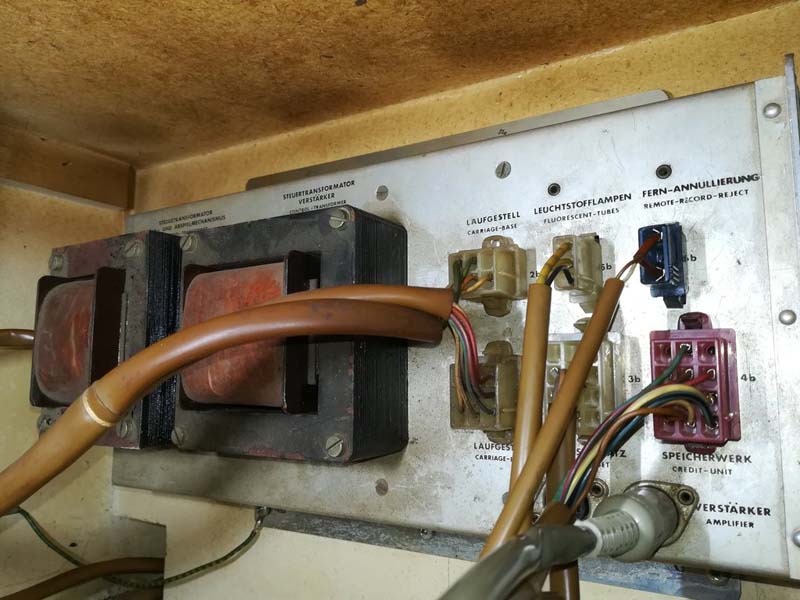
WA B = Wahlanlaufrelais B, WA Z = Wahlanlaufrelais Z, MOT
= Motorrelais, Begr = Begrenzungsrelais
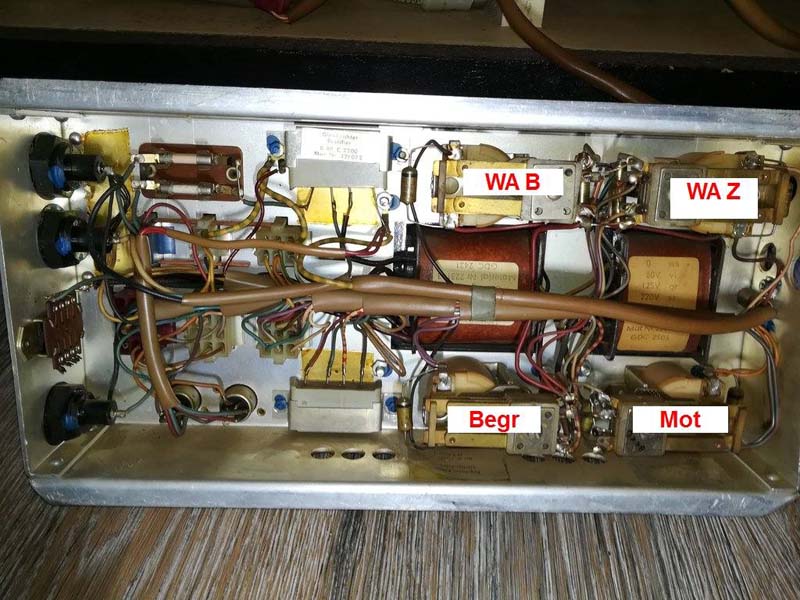
Steuerzentrale Serenade Technik 41396 - Control Centre - 33/45 rpm
| Für Modelle mit Serenade Technik und 2 Geschwindigkeiten - sog. Discothèque Modelle: Festival 130D, Hit 130D, Consul 130D |
For models with Serenade technical equipment and 2 speeds - so called Discothèque Models: Festival 130D, Hit 130D, Consul 130D |
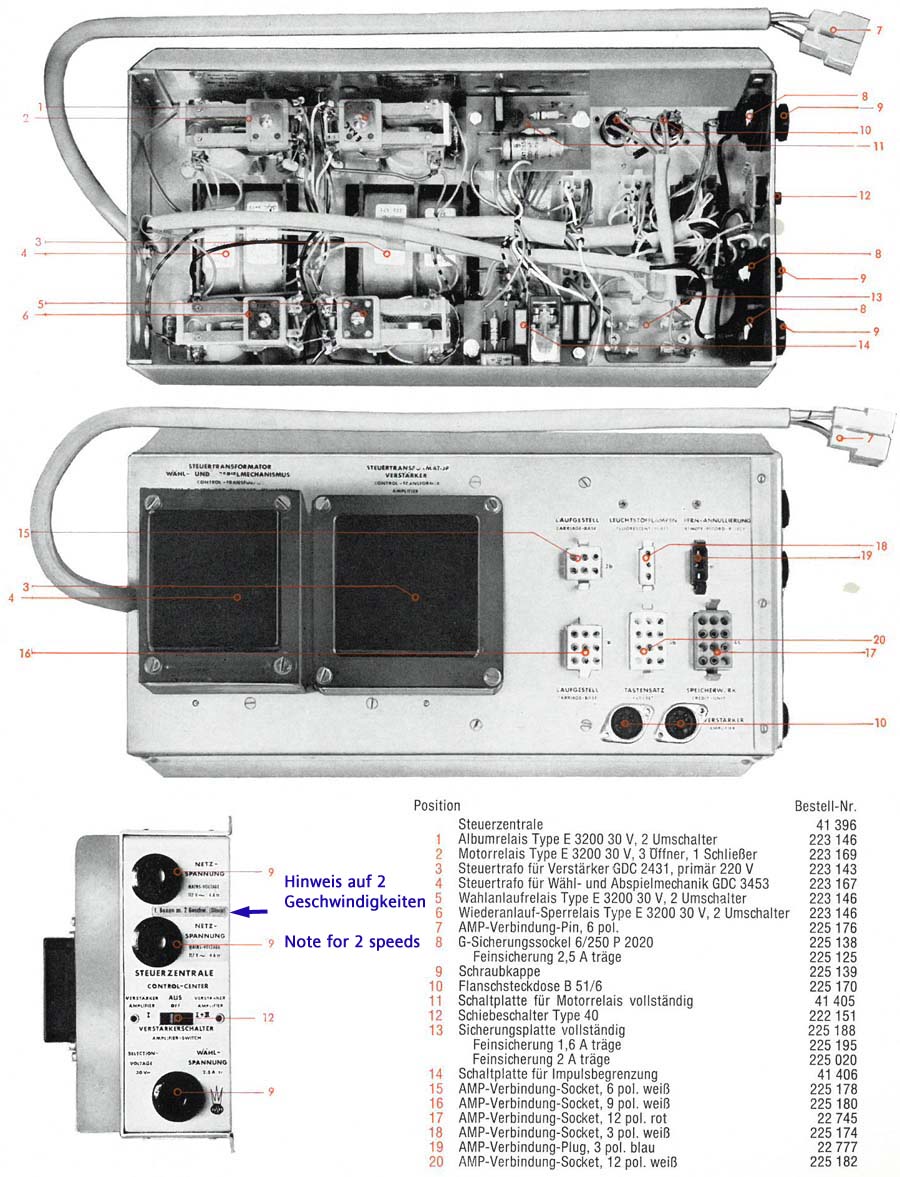
Steuerzentrale #41475 – Control Centre #41475
Die Steuerzentrale
wurde im Verlauf der Jahre technisch angepasst. Z.B.:
|
The control
centre has been technically adapted within the years.
E.g.:
|
Erste Version – First
version:
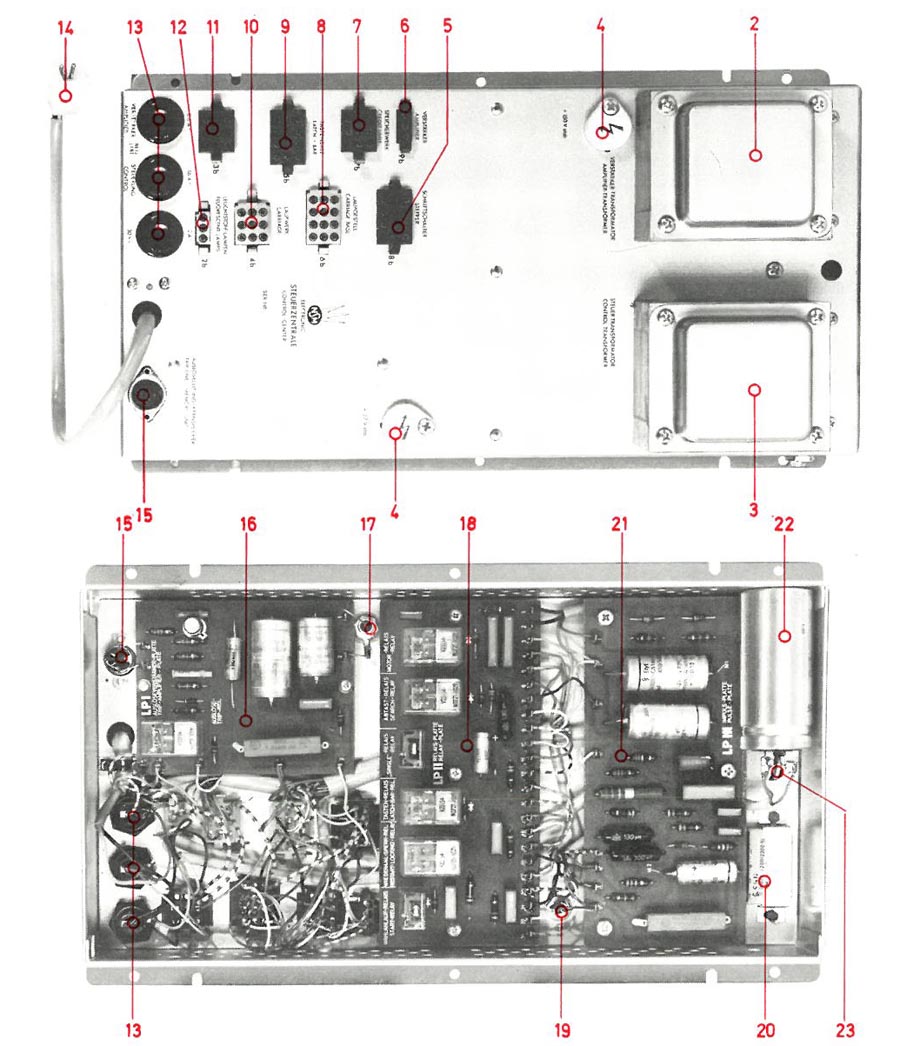
Spätere Version – Later
version:
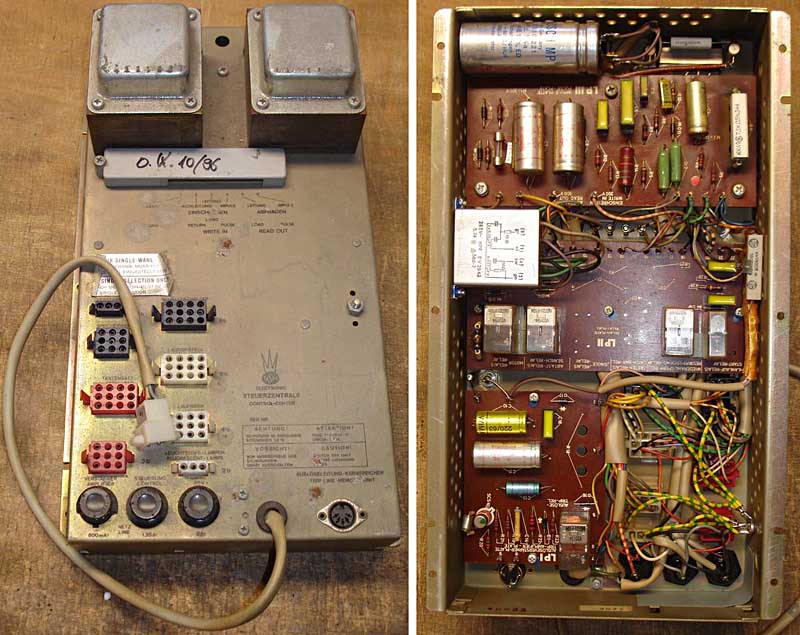
|
Oben rechts dargestellt
ist die Version mit vier Relais für Modelle ohne Albumfuktion.
D.h. die Preiserhöhung für Alben funktioniert nicht. Auf der Rückseite der Tastatur gibt es Auswahlkontakte für jede Nummerngruppe mit 2 Stellungen (1= Single, 2= Album). Beim Betrieb dieser "Spar-Steuerung" sollten alle auf 1 gestellt sein. Mangels Schaltplan einer "Spar-Steuerung" ist uns (bisher) nicht bekannt, ob die Wahl einer Platte aus einer Album-Gruppe trotzdem angenommen wird. Ich schätze aber, dass eine entsprechende Brücke in der Buchse des Tastaturkabels dafür sorgen wird, dass es trotzdem geht. Es wird dann aber wohl nur der Preis einer einfachen Platte abgezogen. Die Wiedergabe einer Album-Platte mit kleinem Loch und 33 UpM läuft davon unabhängig einwandfrei, da die Drehzahlumschaltung rein mechanisch erfolgt. Unten ist die Version mit sechs Relais für Modelle mit Albumfunktion. |
Shown on the upper right is the version with four relays
for models without album feature. This means that the price increase for albums does not work. On the back of the keyboard there are selection contacts for each number group with 2 positions (1= single, 2= album). When operating this "economy control unit" all should be set to 1. Due to the lack of a circuit diagram of this "economy control", we do not know (yet) whether the selection of an album record is accepted anyway. But I guess that an appropriate bridge in the socket of the keyboard cable will make sure that it works anyway. But then only the price of a standard record will be deducted. The plaing of an album record with a small hole and 33 rpm runs fine regardless of this, because the speed switching is purely mechanical. Below the version with six relays for models with Album feaure is shown. |
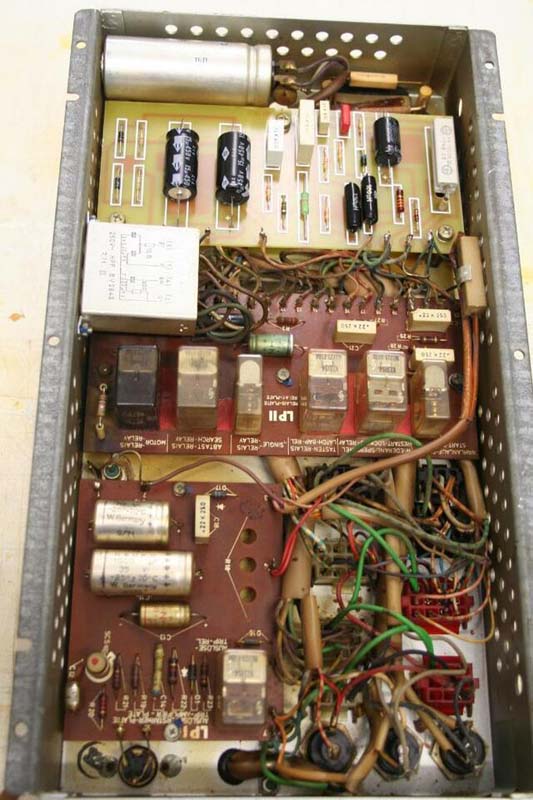
Steuerzentrale #41933
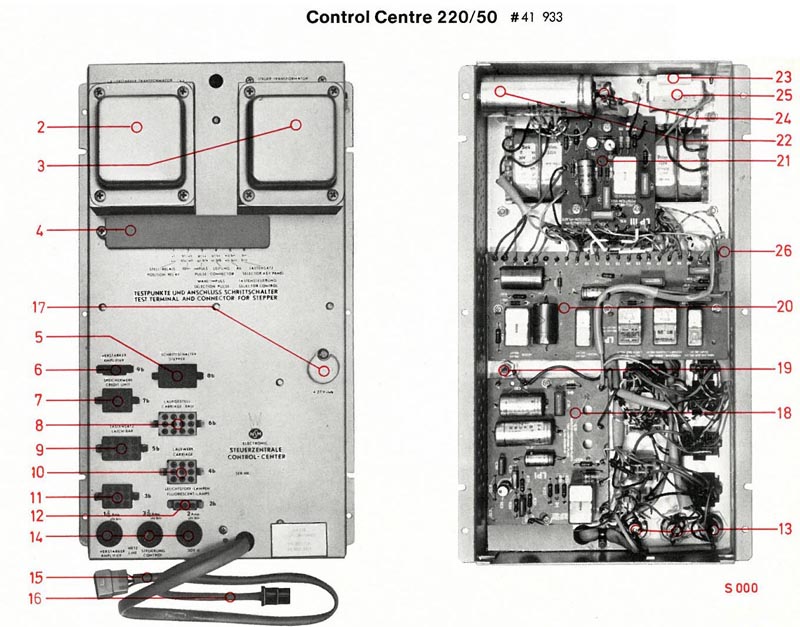
Steuerzentrale #41852
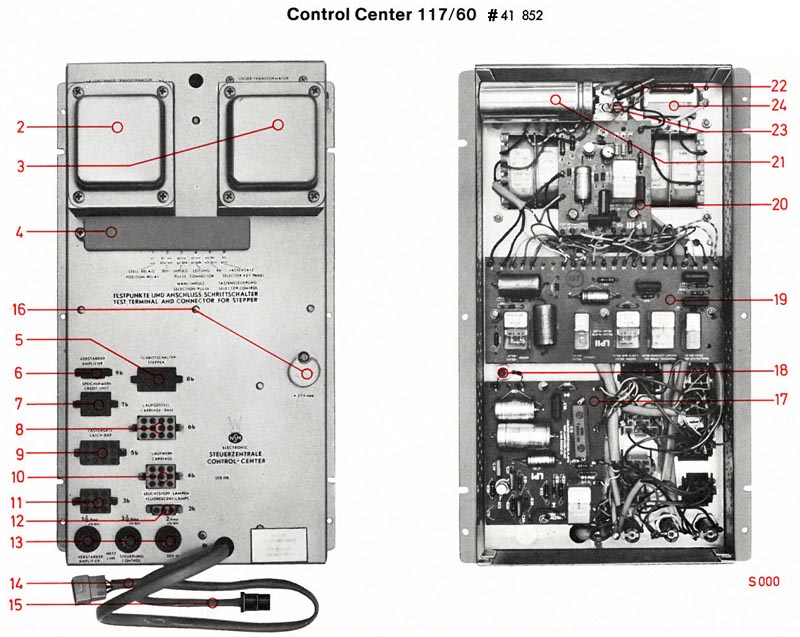
Steuerzentrale #42165 - Control Centre
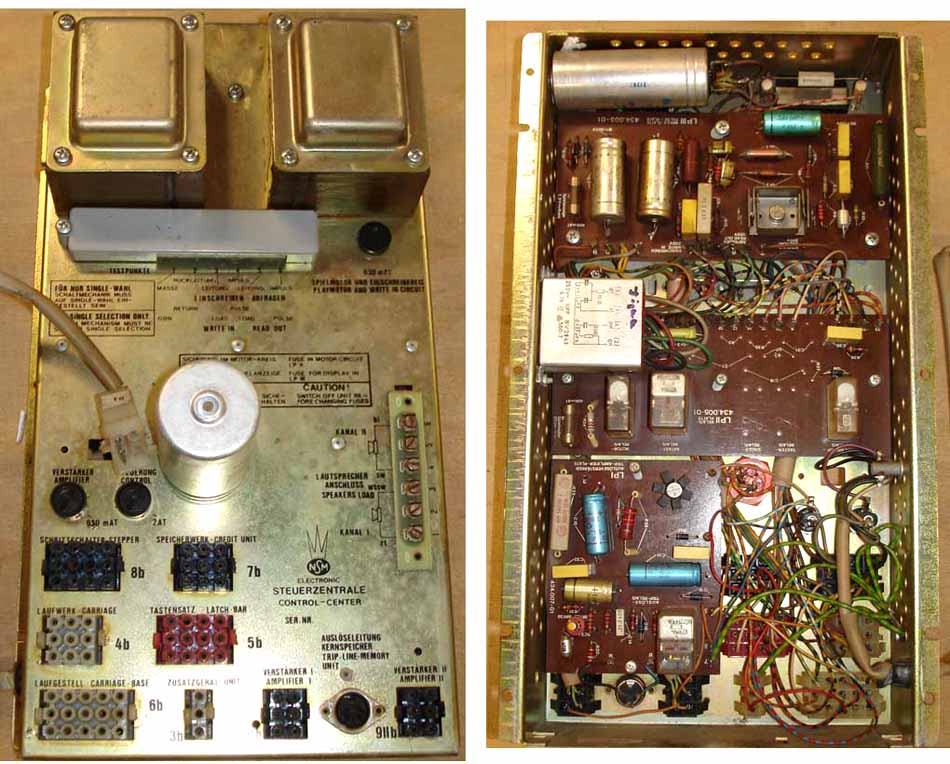
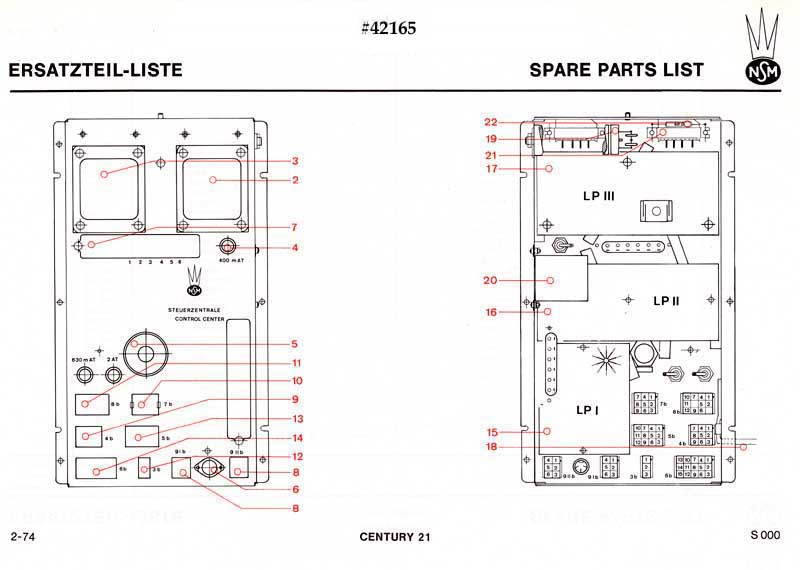
Steuer- und Speichereinheit - Control & Credit Unit
All photos below courtesy of Flamingo Records
Steuer- und Speichereinheit E-Technik #103760 - Control & Credit Unit E-technology
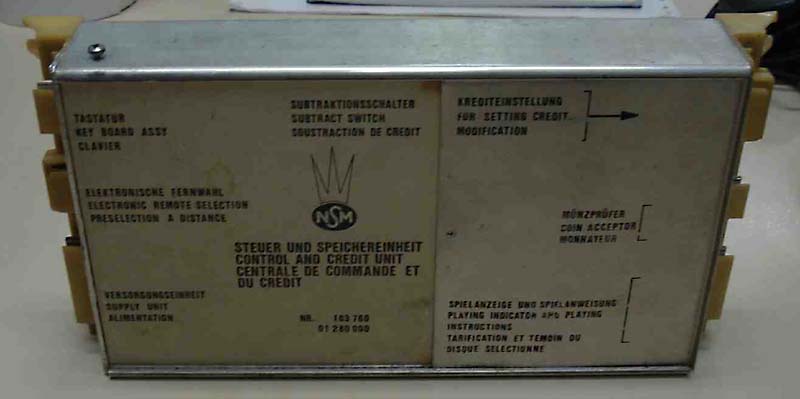
Platine für 103760 - board used in 103760
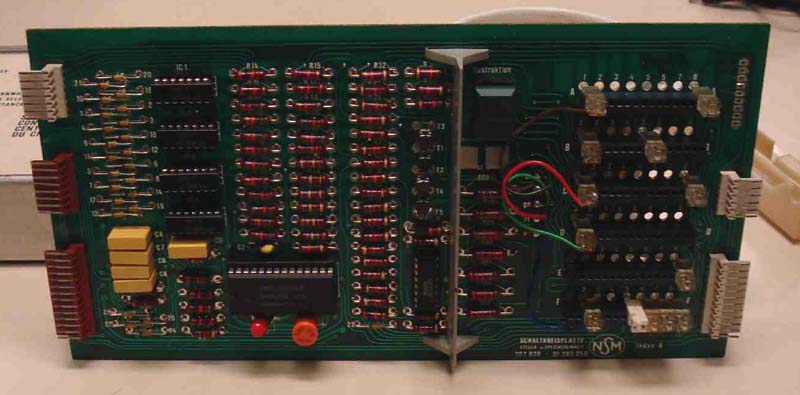
ES Steuer- und Speichereinheit #106590 - Control & Credit Unit
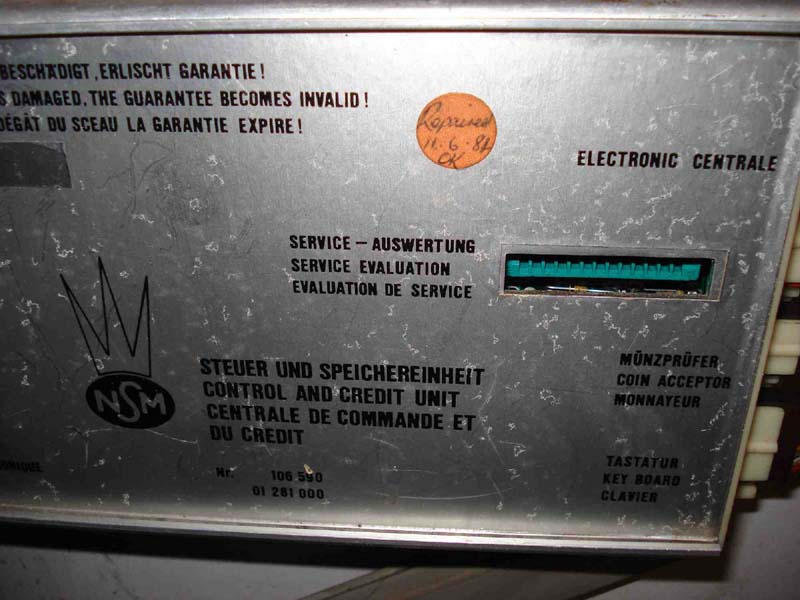
Steuer- und Speichereinheit #171609 - - Control & Credit Unit - can be used instead of 106590
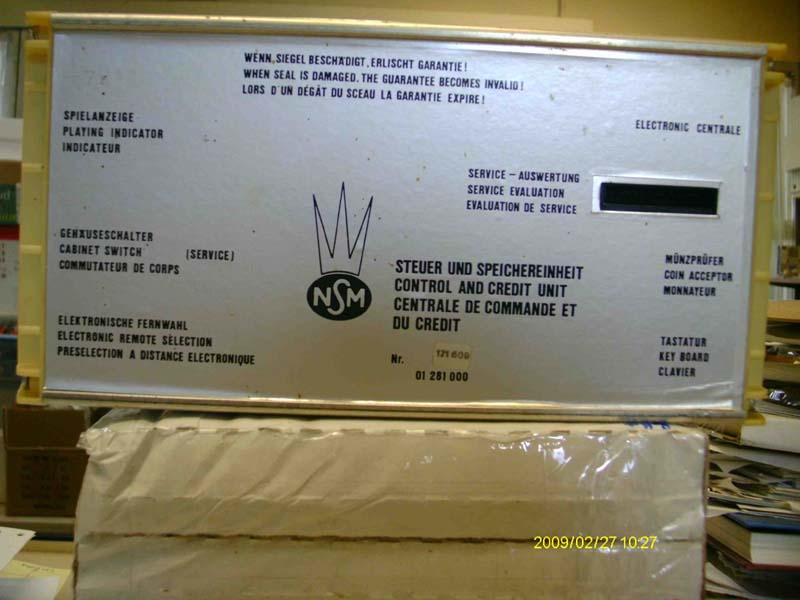
All photos below courtesy of Flamingo Records
ES III Steuer- und Speichereinheit #170160 - Control & Credit Unit
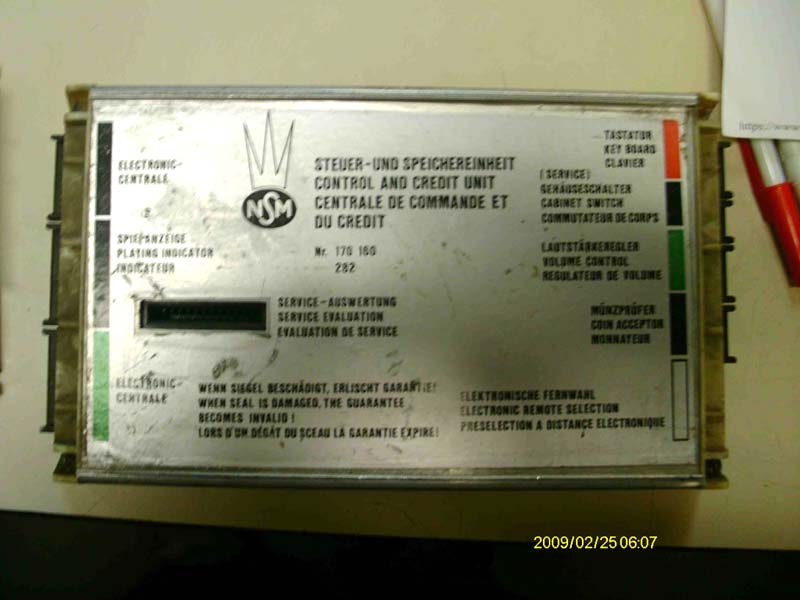
Platine 170026 für 170160 und 170830 - board 170026 used in
170160 and 170830
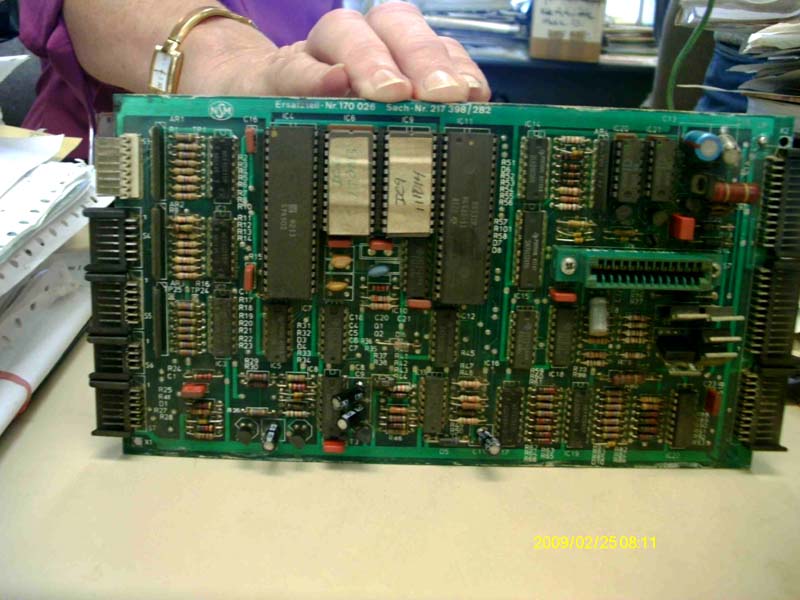
ES III Steuer- und Speichereinheit #170830 - Control & Credit Unit
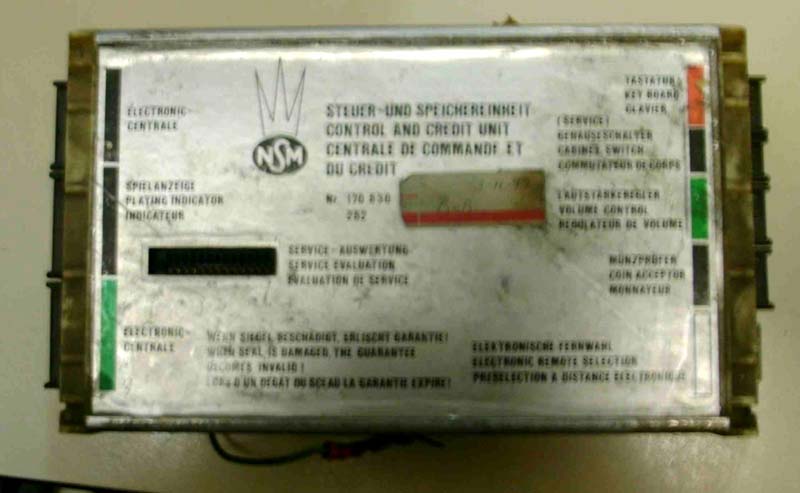
Versorgungseinheit - Supply Unit
Versorgungseinheit 103737 (50 Hz) - Supply Unit
Modelle - Models Century 21E, Prestige E120, Prestige E160, Hit E120, Hit E120A, Consul E120, Consul E160, Hideaway E
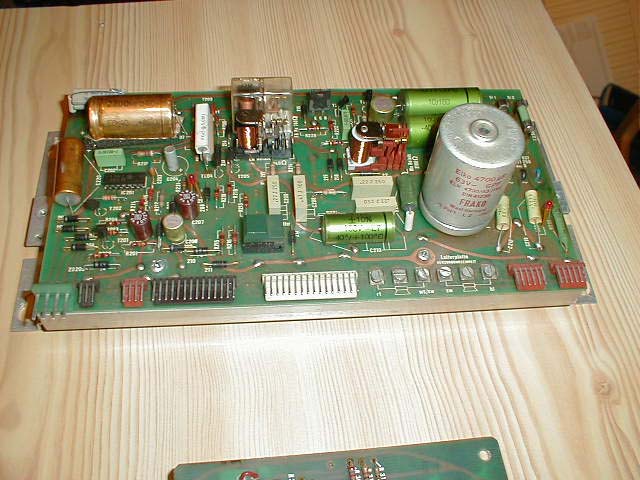


Versorgungseinheit 103954 (60 Hz)
- Sorry, no picture yet -
Zentrale – Centrale
Photos below courtesy of Flamingo Records
"electronic" Zentrale – Centrale 106580 (50 Hz)
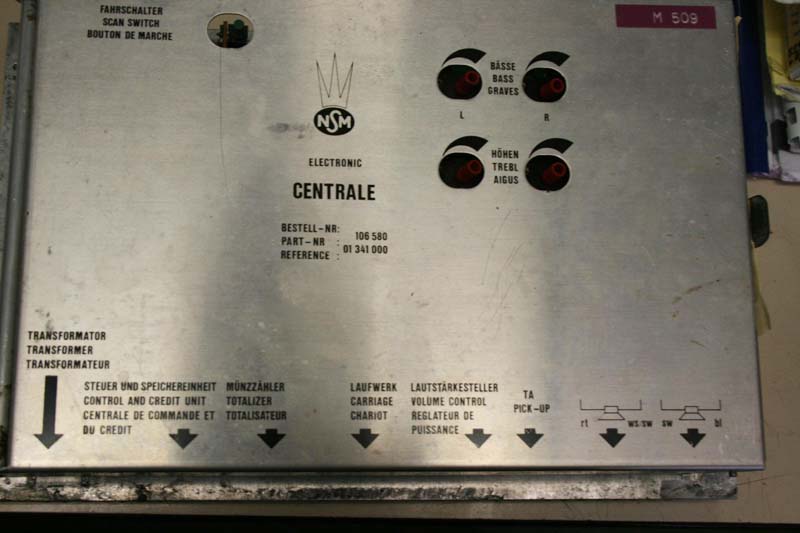
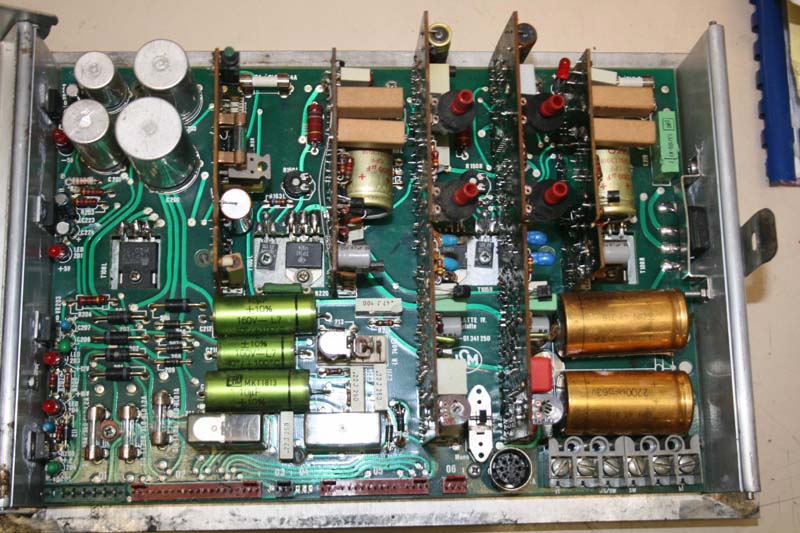
"electronic" Zentrale – Centrale 106730 (60 Hz)

Ich besitze eine NSM Prestige Bb mit zwei quadratischen 50M Verstärkern. Ich habe noch weitere Steuerzentralen und möchte diese testen. Auf einigen steht jedoch, dass sie nur mit einem Verstärker 70S verwendet werden dürfen. Nach dem Studium der Schaltpläne konnte ich keine Unterschiede im Steuerteil entdecken. Ich kann mir nur vorstellen, dass die beiden 50M einen größeren Trafo zur Spannungsversorgung benötigen.
Antwort: Die Aufschrift "Nur mit Verstärker 70S verwenden" bezieht sich
nicht auf die Verstärker 35M, 50M oder 52M, sondern auf die älteren 20M
Verstärker mit Germanium Technik.
Du kannst ohne weiteres auch Steuerzentralen mit dieser Aufschrift in
Deiner Musikbox ausprobieren.
Lediglich Steuerzentralen mit der Aufschrift "Nur für Consul
120" dürfen wg. Schaltungsänderungen nicht in anderen Boxen
verwendet werden.
I have an NSM Prestige
Bb with two square 50M amplifiers. I have another control centres and
would like to test them. On some it says that they can only be used with
a 70S amplifier.
After studying the circuit diagrams I could not find any differences in
the control unit. I can only imagine that the two 50M require a larger
transformer for the power supply.
Answer: The inscription "Use only with amplifier 70S" does not
refer to the amplifiers 35M, 50M or 52M, but to the older 20M amplifiers
with germanium technology.
You can without further ado also try out control centres with this label
in your jukebox.
Only control centrrs with the label "Only for Consul 120" may not be
used in other jukeboxes due to circuit changes.
E-160-Technik: es können nur 120 statt 160 Titel gewählt werden
In der Musikbox sind 80 Singles, jedoch lassen sich nur 60 anwählen. Die ersten 20 sind anwählbar. Wird z.B. 10A gwwählt, wird 30A gespielt.
Antwort: Möglicherweise befindet sich eine Steckdiode auf F7 im Programmfeld. Dann wird aus einer E160 eine E120.
There are 80 records in the jukebox, but only 60 can be selected. The first 20 can be selected. If, for example, 10A is selected, 30A is played.
Answer: There may be a plug-in diode on F7 in the program field. Then an E160 becomes an E120.
Steuer- & Speichereinheit E, ES, ESII: Display zeigt 9C an, die WÄHLE-Lampe leuchtet konstant
Kurz nach dem Einschalten zeigt das Display 9C an und die
WÄHLE Lampe leuchtet konstant. Hat man nach längerem Stillstand z.B.
das Laufwerk irgendwohin geschoben, sieht man für 1-2 Sekunden noch den
Zähler laufen, dann wieder den Fehler. Das Laufwerk fährt aber wie es
soll auf die Startposition und bleibt da auch stehen. Auf Münzeinwurf
und Tastendruck reagiert die Steuerung nicht. Manuell kann eine Position
angefahren und der Abspielvorgang ausgelöst werden, danach bleibt das
Laufwerk stehen. Ein Quertauschen mit Komponenten aus einer anderen
Musikbox mit E-Technik lassen die Einheiten wie Tastatur, Münzung und
Laufwerk ausschließen. Gemessen wird folgendes:
Messen des IC4 am Power ON Ausgang (pin 11): NULL
Der Eingang des Power-Boards (PIN 13) ist ON, aber der Ausgang vom TMS
1000 (Out 3 Pin 24) steht auf 'null'.
Auf der Steuer- und Speichereinheit hat man offensichtlich nachträglich eine kleine
Huckepack-Platine mit etlichen 1N4148 aufgebaut und die PCB hat 'Index
H' aufgedruckt. (Anmerkung: es könnte sich hier um eine Erweiterung im Verlauf der
Produktionszeit zu handeln.)
Bevor auf Verdacht sämtliche UND Gatter und Dioden getauscht werden,
hier die Frage, ob der Fehler bekannt ist oder ob es am
Mikrocontroller selber liegt.
Zum
TMS1000:
Der TMS1000 ist mit einem internen Prom programmiert, welches sich weder
auslesen noch ändern lässt. Verwendet wurde der TMS1000 ab der E-Technik,
deren Programmierung noch vergleichsweise simpel ist und sich an den
elektromechanischen Vorgängern orientiert. Es zeigt sich, dass der TMS1000 selbst
heute eher selten defekt ist. Oft liegen die Ursachen in umgebenden
Bauteilen oder Kontakten. Ohne weiteres neuen Ersatz gibt es nicht, ggfs.
muss man auf ein intaktes originales Bauteil zurückgreifen oder sich
eine technische Alternative bauen.
Dazu der Vorschlag von Swen: die letzte Programm Version von NSM nehmen
und einen Adapter bauen, der Rückwärtskompatibel ist. Wenn ich mich
recht erinnere, gibt es das auch schon was von NSM, einen Adpater für
den 6503. Die Platine wurde, so meine ich zumindest, in den Sockel des
6503 gesteckt und das E-Prom entfernt. Auf dem Adapter war dann ein 6502
und ein 2764 untergebracht - Plug and Play. Man hat ein E-Prom, das von
fast jedem Brenner zu fertigen ist, und einen noch halbwegs gängigen
Prozessor und eine Chance, dass die ganze Geschichte rückwärtskompatibel
bis zur ES Technik ist. Vorteil wäre dann auch, dass man wahrscheinlich
die negativen 5 Volt nicht mehr benötigt. Müsste man dann halt mal
sehen, ob die vom Rechner überwacht werden oder nicht - sprich
Einsparpotenzial bei der Centrale.
1. Zwischeninformation:
Ich habe die Und Gatter getauscht.... und zuerst sah Alles toll
aus: Die Anzeige leuchtete korrekt, der Schlitten fuhr, zum Startpunkt
konnte man im Display die Zahlen erkennen, bis das Laufwerk in die
NULL-Position gefahren ist... und dann: brennt IC 4 durch.
Kann es sein dass es CD4081 Bausteine gibt, die weniger zuverlässig bzw.
belastbar sind?
2. Zwischeninformation:
Werksseitig wurden HEF4081 verwendet. CD4081BE wurden auch als Ersatz
verwendet.
Ergebnis:
Es lag tatsächlich an den ICs. Die ICs mit der Bezeichnung CD4081BD von
dem Hersteller ARSS (!) scheinen wirklich nicht mit der Betriebsspannung
von nahezu 16V klarzukommen und brennen im Ruhezustand durch.
Es wurden jetzt CD4081 BE von Texas Instruments verwendet. Und diese
halten!
Shortly after
switching on, the display shows 9C and the SELECT lamp lights up
constantly. If the carriage has been moved somewhere after a longer
standstill, for example, it can be seen that the counter is running for
1-2 seconds, then the error occurs again. However, the carriage moves to
the start position as it should and remains there. The controller does
not react to inserting a coin or pressing a button. A position can be
approached manually and the playing sequence released, after which the
carriage stops. Cross-swapping with components from another jukebox with
E-technology excludes units such as the keyboard, coin mechanism and
carriage.
The following is measured:
Measure IC4 at the Power On output (pin 11): ZERO
The input of the power board (pin 13) is ON', but the output of the TMS
1000 (Out 3 pin 24) is ZERO.
A small piggyback board with several 1N4148s has obviously been added to
the control and credit unit and the PCB has "Index H" printed on. (Note:
This could be an technical upgrade in the course of production).
Before all AND gates and diodes are replaced on suspicion, here is the
question of whether the error is known or whether it is even the
microcontroller itself.
About the TMS1000:
The TMS1000 is programmed with an internal prom, which can neither be
read out nor changed. The TMS1000 was used from the E-technology onwards,
the programming of which is still comparatively simple and based on its
electromechanical predecessors. It turns out that even today the TMS1000
is rarely defective. The causes often lie in surrounding components or
contacts. New replacements are not readily available, if necessary, it
is needed to fall back on an intact original component or build a
technical alternative.
Swen's suggestion: Take the latest program version of NSM and build an
adapter that is backwards compatible. If I remember correctly, there is
already something from NSM, an adapter for the 6503. I think the circuit
board was plugged into the socket of the 6503 and the E-Prom removed.
The adapter then housed a 6502 and a 2764 - plug and play. You have an
E-Prom that can be manufactured by almost any recorder, a processor that
is still reasonably common and a chance that the whole thing is
backwards compatible up to ES technology. Another advantage would be
that the negative 5 volts would probably no longer be needed. You would
then have to see whether they are monitored by the computer or not - i.e.
potential savings for the central unit.
1st interposed
information:
I swapped the AND gates.... and at first everything looked great: The
display lit up correctly, the carriage moved, at the starting point the
numbers could be seen in the display until the carriage moved to
the ZERO position... and then: IC 4 burnt.
Is it possible that there are CD4081 components that are less reliable
or less resilient?
2nd interposed
information:
HEF4081 were used at the factory. CD4081BE were also used as a
replacement.
Result:
It was indeed due to the ICs.
The ICs with the designation CD4081BD from the manufacturer ARSS (!)
really don't seem to be able to cope with the operating voltage of
almost 16V and burn out in idle state.
CD4081 BE from Texas Instruments have now been used. And they keep good!
Die Angaben
haben keinen Anspruch auf Vollständigkeit oder Richtigkeit.
Bei den (importierten) Boxen können im Laufe der Jahre durchaus
Veränderungen vorgenommen worden sein. Copyright.
<<<
NSM
Ein Service von

Copyright by Stamann
Musikboxen